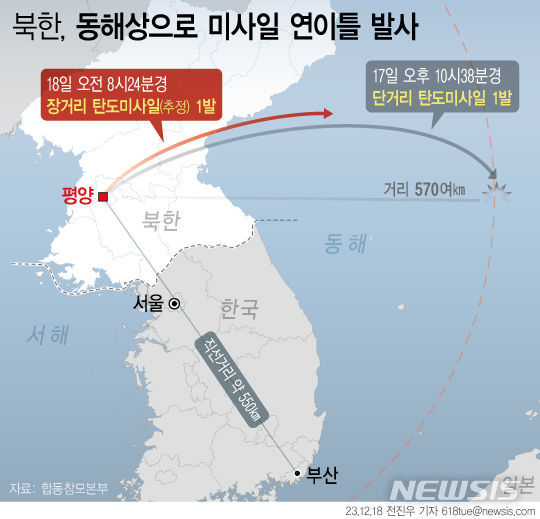Following the launch of a short-range ballistic missile (SRBM) the day before, North Korea launched a long-range ballistic missile on the 18th, carrying out provocations for the second day in a row. Accordingly, the President’s Office held an emergency National Security Council (NSC) meeting this morning, chaired by National Security Office Director Cho Tae-yong, to discuss response measures.
According to the Joint Chiefs of Staff, our military detected a long-range ballistic missile launched from the Pyongyang area into the East Sea at around 8:24 a.m. on this day. The Joint Chiefs of Staff said, “Our military will keep a close eye on North Korea’s various activities under a solid ROK-US joint defense posture and maintain the ability and posture to respond overwhelmingly to any provocation.”
In addition, the Joint Chiefs of Staff said, “North Korea’s missile launch this time is a serious provocative act that harms the peace and stability of the Korean Peninsula as well as the international community,” and added, “We strongly condemn it as a clear violation of the ‘United Nations (UN) Security Council Resolution.’” At the same time, he said, “South Korea, the United States, and Japan were prepared to jointly detect and track, and warning information about North Korea’s launched ballistic missiles was closely shared among the three parties.”
 According to the Joint Chiefs of Staff, North Korea launched a short-range ballistic missile (SRBM) on the night of the 17th, and then fired an estimated long-range ballistic missile (ICBM) again on the morning of the 18th, 10 hours later.
According to the Joint Chiefs of Staff, North Korea launched a short-range ballistic missile (SRBM) on the night of the 17th, and then fired an estimated long-range ballistic missile (ICBM) again on the morning of the 18th, 10 hours later.According to the Joint Chiefs of Staff, the missile was launched at a high angle and landed in the East Sea after flying about 1,000 km. According to Japan’s NHK, the missile was estimated to have fallen into the East Sea outside Japan’s exclusive economic zone (EEZ), about 250 km west of Okushirito, Hokkaido, at around 9:39 a.m. Accordingly, the President’s Office plans to hold an NSC meeting after completing the missile-related analysis and conduct an inspection of the situation and security posture.
Recently, our military is watching the possibility of North Korea’s intercontinental ballistic missile (ICBM) provocation. On the 15th (US local time), First Deputy Director of the National Security Office Kim Tae-hyo said, “There is a possibility that North Korea will test-launch an ICBM within this month.” If North Korea launched an ICBM on this day, it would be the fifth launch this year, six months after the launch in July. This is the largest number of ICBM launches in one year. According to NHK, the missile launched that day was estimated to have flown at a maximum altitude of over 6,000 km. Accordingly, the media analyzed that the missile was likely an ICBM. An official from the Japanese Ministry of Defense told NHK, “There is a possibility that the missile launched this time was launched at a high angle (lofted orbit).”
Some say that North Korea’s series of provocations resulted in an agreement between South Korea and the U.S. at the Nuclear Consultative Group (NCG) meeting held in the U.S. on the 15th (local time) to “train together, including nuclear operation scenarios, in joint training between South Korea and the U.S. starting next year.” It is being interpreted as a backlash against . The previous day (the 17th), North Korea had stated in a statement by the Ministry of Defense spokesperson released through telecommunication immediately after the launch of the ballistic missile that this launch was a protest against the results of the NCG meeting and the arrival of the US nuclear-powered submarine Missouri (SSN-780) in Busan.
North Korea, which carried out missile provocations for two days in a row, criticized the South Korean military, which had strengthened its preparedness against North Korea after the September 19 inter-Korean military agreement was effectively annulled, of being “bluffing.” North Korean media outlet Chosun Central News Agency published a comment that day, saying, “Even a pretentious airplane can be struck by lightning,” adding, “They said a frightened dog barks louder,” and added, “Due to the treasonous and irresponsible actions of a group of traitors, the area of the Korean peninsula is now in danger.” “A situation of imminent tension is being created,” he said.
Meanwhile, it is reported that the Japanese government will also hold an NSC meeting as soon as possible to check the situation of North Korea’s provocations. On this day, Japanese Prime Minister Fumio Kishida met with reporters while heading to his official residence and said, “We will receive detailed reports on the issue in the future and confirm the current situation before holding the NSC.”
Lee Ye-ji,
Source: Donga
Mark Jones is a world traveler and journalist for News Rebeat. With a curious mind and a love of adventure, Mark brings a unique perspective to the latest global events and provides in-depth and thought-provoking coverage of the world at large.